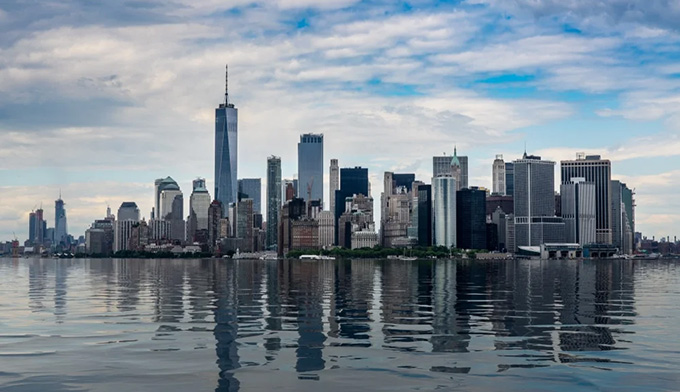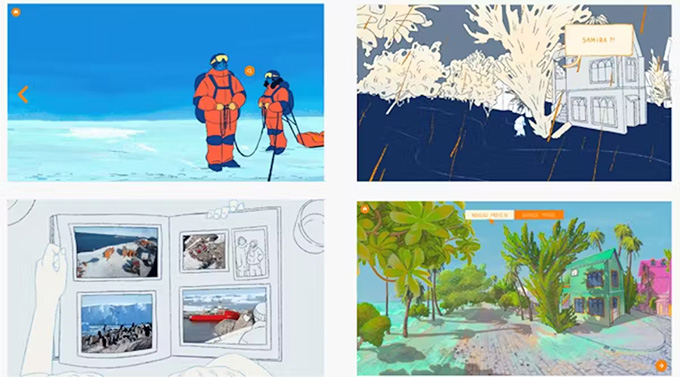
How can we show young people that the future is not fixed and that they have a role to play in it? This is the challenge taken up by PROTECT, a European research project, combined with an interactive digital game.
In May 2024, the last glacier in Venezuela disappears . At the same time, in Panama, the first climate refugees in Latin America leave the “crab island” to escape rising waters. In France, 500,000 homes are threatened by 2100 .
These are facts that, in the eyes of young people, are increasing concerns about the environmental crisis. Many believe that it is “already too late to slow down climate change before it causes devastating effects” or feel powerless in the fight against climate change. How can we show them that the future is not fixed and that they have a role to play?
This is the challenge taken up by PROTECT , a European research project, with the interactive digital initiative Sea Level Expedition , created by Clémence Foucher, scientific illustrator.
Sea Level Expedition also aims to bring together two seemingly distant worlds: coastal regions and polar ice caps and glaciers. What is the connection between these two environments? Why does the disappearance of glaciers lead to rising sea levels? What mechanisms underlie these phenomena and what is the role of human activities?
A story where you are the hero
According to a 2022 survey of 72 middle school students , four activities dominate their free time: watching a series, being with friends, playing video games, and spending time with family.
Sea Level Expedition meets these interests by offering an activity that is chaptered (like a series), collaborative (to be done in a group), interactive (like a video game), while telling the story of a family (like a shared moment).
The activity takes place in three chapters, structured like a play.
In the first chapter, presented in video form, we are in 2081 in the Maldives in a scenario with very strong warming (+3.3-5.7 °C compared to 1850-1900). Samira, a young Maldivian, visits her grandparents who see their house invaded by rising waters. In the middle of a storm, her grandmother tells her about her first mission to Antarctica, in 2026.
The second chapter takes us back to 2026. Samira wakes up in her grandmother’s shoes, on the French scientific base of Dumont D’Urville, in Antarctica. On the Astrolabe glacier, she discovers glacial processes and the loss of glacier mass through quizzes and interactive games, understanding their contribution to rising sea levels.
In the third and final chapter, players must make life choices. Depending on their decisions, three possible futures emerge in 2081: limited warming (+1–1.8 °C compared to 1850–1900), intermediate warming (+2.1–3.5 °C), and very strong warming (+3.3–5.7 °C). This chapter highlights the impact of human activities on the climate and how they shape our future.
Inform without alarming
This activity offers a simple, yet scientifically rigorous, visual and narrative discourse. “I sought to synthesize the message while allowing players to identify with the characters and project themselves into the story,” explains Clémence Foucher, scientific illustrator and creator of the activity. To do this, her work is based on real places, where the drawing simplifies and highlights certain elements essential to understanding.

Sea Level Expedition, illustration by Clémence Foucher on the right based on an actual photo on the left.
Faced with a subject that is often a source of anxiety, this activity moves away from catastrophic speeches, while remaining anchored in reality. The tone adopted is factual and scientific, without morality or judgment. The players thus embark on a scientific expedition that gives them the keys to understanding complex phenomena, for example in chapter 2 which takes place on the Astrolabe glacier.
The structure of the activity was also designed to limit eco-anxiety . By starting the story in the context of a climate scenario with very strong warming, the audience has the opportunity to anchor themselves in a scientific reality and therefore limit the imagination that can quickly exacerbate the catastrophe. They will then be in charge of rebuilding or avoiding this future by understanding the processes and mechanisms at play on which they may or may not have an impact.
So the goal is to transform anxiety that can be paralyzing into a driving force through learning.
A multiple choice story
Beef burger or veggie burger? Train or plane? Car or bike? These are all choices that young people face throughout their lives, and which have a direct impact on the climate. Through this series of decisions, we seek to raise awareness among young people about the opportunities for change, without judgment.

Sea level expedition, illustrations by Clémence Foucher.
Players explore three possible futures in Chapter 3. They must then adapt to these climate futures, where sea levels are higher or lower. Depending on the case, adaptation will be more or less easy, and sometimes, moving is the only option, as is already the case in the most vulnerable regions of the world .
The Sea Level Expedition initiative embodies the idea that the future is not fixed, but is shaped by our collective and individual actions. By giving young people the tools to understand the causes and consequences of sea level rise, they are invited to become agents of change, armed with scientific knowledge.
Author Bios: Gael Durand is CNRS Research Director at the Institute of Environmental Geosciences and Anne Chapuis is the CNRS communications officer at the Institute of Environmental Geosciences both at the University of Grenoble Alpes (UGA)
